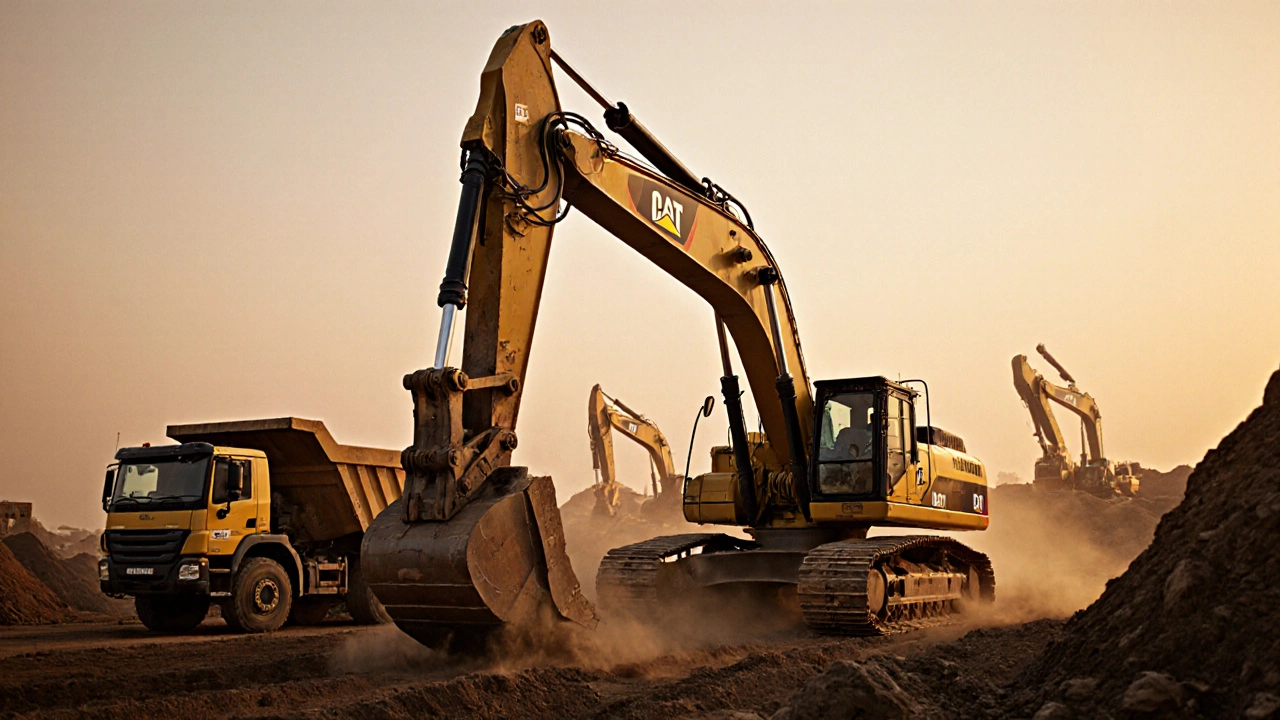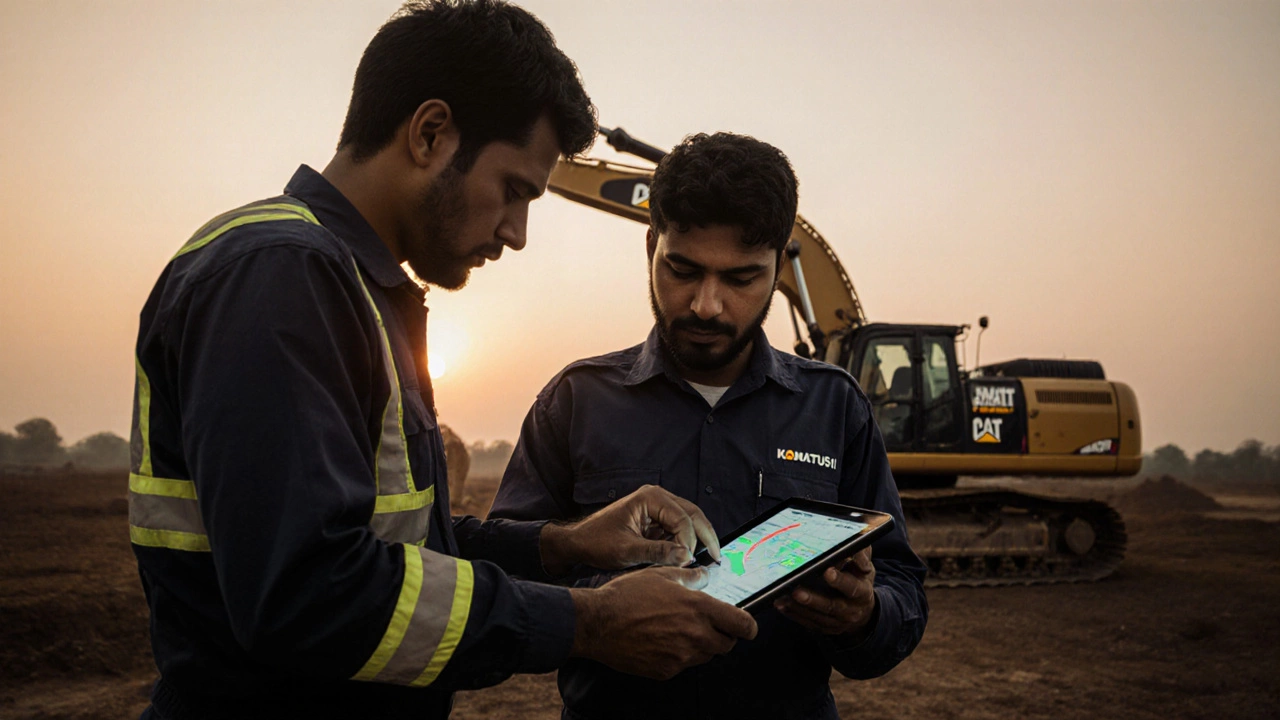
Caterpillar vs Komatsu Revenue Calculator
Revenue Comparison Tool
See how close Komatsu gets to Caterpillar's revenue. Input Komatsu's revenue in billions to calculate the gap.
Caterpillar Revenue
$57.3BKomatsu Revenue
$39.1BWhat If Komatsu Reached Caterpillar's Size?
To match Caterpillar's revenue, Komatsu would need to grow by 46.5%.
When you think of heavy machinery, two names instantly come to mind: Caterpillar and Komatsu. Both make the earth-moving machines you see on every major construction site-from giant excavators to massive dump trucks. But which one is truly bigger? It’s not just about how many machines they sell. It’s about revenue, global reach, workforce size, and who controls the most market share. Let’s break it down with real numbers, not hype.
Revenue: The Clear Leader
In 2024, Caterpillar reported $57.3 billion in total sales. Komatsu, its closest rival, brought in $39.1 billion. That’s a gap of nearly $18 billion. Caterpillar’s lead isn’t new-it’s been consistent for over a decade. In 2020, Caterpillar made $41.5 billion; Komatsu made $32.1 billion. The gap widened, not narrowed. Why? Caterpillar owns more brands under its umbrella. It doesn’t just sell machines. It owns Cat Financial, which provides leasing and loans to customers worldwide. That’s a massive profit engine most competitors don’t have.
Market Share: Who Controls the World?
When it comes to global market share in construction and mining equipment, Caterpillar holds about 28%. Komatsu sits at 17%. Those numbers come from industry reports by McKinsey and the Equipment Manufacturers Institute. In the U.S., Caterpillar’s dominance is even starker-it controls over 40% of the earthmoving equipment market. Komatsu has a stronger presence in Japan and parts of Southeast Asia, but in North America, Europe, and Australia, Caterpillar is the default choice. Contractors don’t just buy Caterpillar because it’s reliable. They buy it because parts and service are available in almost every town.
Workforce and Global Footprint
Caterpillar employs around 103,000 people worldwide. Komatsu has about 68,000. That’s a difference of over 35,000 jobs. Caterpillar has manufacturing plants in the U.S., Brazil, China, India, and Germany. Komatsu’s main factories are in Japan, China, and the U.S., but its global distribution network is smaller. Caterpillar’s dealer network spans over 170 countries. Komatsu operates in about 100. That’s not just a difference in scale-it’s a difference in accessibility. If you’re running a mine in Botswana or a highway project in Indonesia, who can send a technician to your site within 24 hours? Caterpillar can.
Product Range: Breadth Matters
Caterpillar doesn’t just make excavators. It builds diesel engines used in ships, power plants, and locomotives. Its engines power everything from oil rigs to data centers. Komatsu focuses more narrowly on construction and mining equipment. Komatsu does make some industrial engines, but they’re mostly for their own machines. Caterpillar’s product line includes:
- Hydraulic excavators
- Wheel loaders
- Articulated trucks
- Dozers and graders
- Miners’ haul trucks (up to 400 tons)
- Gas and diesel engines (from 50 hp to 20,000 hp)
- Power generation systems
- Fluid power systems and transmissions
Komatsu’s lineup is strong, but narrower. It doesn’t make engines for third parties. It doesn’t offer financial services. It doesn’t build power systems for remote villages. That’s not a weakness-it’s a strategy. But when you’re measuring “bigger,” breadth counts.
India: The Growing Battleground
India is one of the fastest-growing markets for heavy machinery. The government’s National Infrastructure Pipeline plans to invest over $1.4 trillion by 2025. That means more roads, ports, and mines. Both companies are fighting hard here. Caterpillar has a manufacturing plant in Chennai and over 200 dealers across India. Komatsu opened its first Indian plant in 2017 in Pune. It’s growing fast, but Caterpillar still leads in sales volume. In 2024, Caterpillar sold over 12,000 units in India. Komatsu sold about 7,500. Why? Caterpillar’s used equipment market is huge. Indian contractors often buy Cat machines secondhand. Komatsu’s resale value is good, but its used inventory is smaller.
Technology and Innovation
Both companies are investing heavily in automation and electric machines. Caterpillar’s “Connected Machine” platform lets operators track fuel use, maintenance needs, and location in real time. Komatsu has its “SmartConstruction” suite, which uses drones and AI to map job sites. But Caterpillar has been doing this longer. Its telematics system, Cat Connect, has been around since 2010. Komatsu’s system launched in 2016. By 2024, over 1.2 million Caterpillar machines were connected to the cloud. Komatsu had about 650,000. That’s not just tech-it’s data. More data means better service, smarter parts inventory, and faster fixes.

Who Wins? It Depends on What You Mean by “Bigger”
If you mean who makes more money? Caterpillar. Who has more employees? Caterpillar. Who has more machines in the field? Caterpillar. Who has better global service? Caterpillar. Who’s more innovative in telematics? Caterpillar. But Komatsu isn’t small. It’s a powerhouse. It’s known for reliability. Its machines often last longer with fewer breakdowns. In Japan, Komatsu is a national icon. In mining, its haul trucks are some of the most efficient in the world.
But when you stack them up-revenue, scale, reach, product range, and service-Caterpillar is bigger. Not just slightly. Significantly. It’s the giant. Komatsu is the strong challenger, but it’s still playing catch-up.
What This Means for Buyers
If you’re a contractor in India, the U.S., or Brazil, Caterpillar gives you more options, faster support, and better resale value. If you’re buying a single excavator for a small job and price is everything, Komatsu might be cheaper upfront. But over five years, with fuel, parts, and downtime, Caterpillar often costs less. The machines are built to last. The parts are everywhere. The service network is unmatched.
There’s no shame in choosing Komatsu. But if you’re asking who’s bigger-Caterpillar is the answer.
Is Komatsu better than Caterpillar?
It depends on what you need. Komatsu machines are often more fuel-efficient and have excellent build quality, especially in mining. Many contractors in Japan and Australia prefer Komatsu for its reliability. But Caterpillar offers more machine types, better global service, and stronger resale value. For most buyers outside Japan, Caterpillar is the safer, more supported choice.
Which company has more machines in India?
Caterpillar has more machines in India. In 2024, Caterpillar sold over 12,000 units, while Komatsu sold around 7,500. Caterpillar’s used equipment market is also much larger, with thousands of secondhand machines in circulation across the country. Its dealer network covers over 200 locations, making parts and repairs easier to access.
Do Caterpillar and Komatsu make the same types of machines?
They overlap heavily in excavators, dozers, loaders, and haul trucks. But Caterpillar also makes diesel and gas engines for ships, power plants, and trains. It offers financial services, telematics systems, and power generation equipment. Komatsu focuses almost entirely on construction and mining machinery. It doesn’t sell engines to other companies or offer leasing programs.
Why is Caterpillar more expensive?
Caterpillar machines cost more upfront because they’re built for longer life, higher uptime, and global serviceability. The parts are standardized across continents, and service networks are deeper. Komatsu is cheaper to buy, but if you need a rare part in rural India, waiting weeks for delivery can cost you more in lost time than the initial price difference.
Which company is growing faster?
Komatsu is growing faster in percentage terms, especially in electric machinery and automation. But Caterpillar’s growth is bigger in absolute dollars. In 2024, Caterpillar added $5.2 billion in revenue. Komatsu added $3.8 billion. Komatsu is catching up in innovation, but Caterpillar still leads in scale and market penetration.
Final Thought: Bigger Isn’t Always Better-But It’s Harder to Beat
There’s no doubt Komatsu makes excellent machines. But when you look at the full picture-revenue, global reach, service, product range, and market control-Caterpillar is the clear leader. It’s not just a machine maker. It’s an ecosystem. And that ecosystem is what keeps contractors coming back, year after year, no matter where they are in the world.